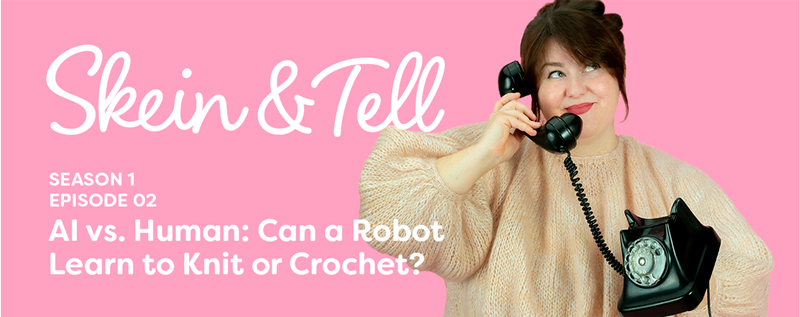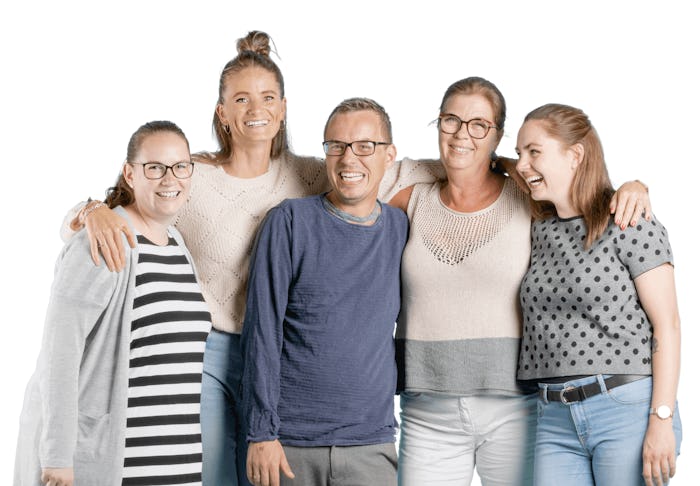In this episode of Skein and Tell, Gea dives into the fascinating clash between technology and tradition: Can AI really learn to knit or crochet? From robot-made sweaters to pattern scams, we’re unraveling what the future holds for fiber arts.

Welcome back, yarn bestie! In this second episode of Skein and Tell, Gea takes us on a fascinating journey into the world of artificial intelligence and yarn. 🤖🧵
We’re asking the big question: Can a robot really knit or crochet? From robotic arms and 3D knitting machines to the emotional magic only human hands can create, this episode explores the intersection of technology, creativity, and tradition in the fiber arts world.
Listen to Skein and Tell Episode 2 Now
Press play to dive into the full conversation – or scroll down to read the episode highlights and full transcript below.
Choose Where to Listen:
Can’t tune in right now? 🙈 Catch what Gea covers below.
Want More? Read the Entire Episode
Below is an edited transcript from Episode 2: AI vs. Human – Can a Robot Knit or Crochet? Originally presented on the Skein and Tell podcast.
GEA: Hey, yarn bestie. It's me, Gea. Welcome back to Skein and Tell. Today we've got an incredibly intriguing episode that merges two worlds you might not think go hand in hand: artificial intelligence and fiber arts.
That's right. Today we're asking the big question: Can a robot learn how to crochet or knit? With AI technology advancing at an insane pace, we’re seeing all kinds of mind-blowing innovation. But what happens when we take this cutting-edge technology and ask it to do something as tactile, personal, and nuanced as knitting and crocheting? Can a robot truly replicate the artistry, creativity, and human touch of crafting with yarn? Can it write a pattern and then knit it? Or are there things that only humans can do with needles and hooks?
Grab your yarn and your tech curiosity, we're diving deep into the world of AI, knitting, and crochet, and the potential future where robots might just be stitching alongside us.
Before we get into specifics, let's take a quick look at what AI is and how it's been evolving. AI, or artificial intelligence, refers to machines that can simulate human intelligence, learn from data, improve over time, and perform tasks that require creativity and adaptation. We’ve already seen AI in things like self-driving cars, smart assistants like Siri or Alexa, and even in art creation. But can it take on something as hands-on as crochet or knitting?
To understand whether AI can learn to knit, it’s essential to recognize that AI can already create art – paintings, poetry, and music – by learning from the vast amounts of data and examples we feed it. Some systems are trained to recognize patterns and replicate human creativity. This opens the door to the idea that AI might be able to replicate or even innovate in fiber arts. But knitting and crocheting? Let's see.
Now that we know what AI is capable of, let’s look at the possibility of a robot crocheting or knitting. The main question here is whether a robot can replicate the same precision, creativity, and human connection that goes into every stitch.
There have been various attempts to create machines that can perform knitting. From automated knitting machines used in industrial settings to more experimental robots designed to mimic hand knitting. Crocheting hasn’t been replicated in a machine yet, but knitting has. So let's focus on knitting for now.
Some of the first examples of robotic knitting started around the 2010s. Researchers were testing machines that could emulate the craft of hand knitting. Robotic arms equipped with sensors and advanced programming were designed to move yarn, wrap it around needles, and complete stitches. But they lacked the fine motor skills and creative flair that humans bring to knitting. So while they could produce fabric, they weren’t really knitting in the artistic, human sense.
In 2017, a team at the University of Tokyo developed a robot designed to knit using yarn. The results were basic. It could perform simple stitches but needed meticulous human programming and lacked the subtlety and artistry of a person’s touch. It’s not quite ready to knit a sweater yet.
The idea of robots being able to understand your intention, stitch consistency, or reading a pattern is still being explored, and that’s mind-blowing.
So what makes knitting and crocheting so human that AI might struggle to replicate it? The beauty of these crafts isn’t just in the mechanical process. It’s in the personal expression and creativity. From choosing colors to adjusting tension, every person’s technique is unique. Knitting and crocheting have been passed down for generations as a form of connection. Whether you're making something for a friend, creating a family heirloom, or stitching warmth into a blanket, it’s deeply emotional and personal.
One thing that makes handcrafting so special is the way imperfection adds character. We all make mistakes – dropped stitches, uneven tension, temperature or humidity affecting yarn behavior, or your own body tension while crafting. These little things can turn into happy accidents that shape a finished project into something totally unique.
For AI to replicate that kind of creativity, it would need to embrace imperfection in a way that goes beyond pre-programmed instructions. Humans often see beauty in imperfection – even when we’re frustrated with our own mistakes, others see the charm. AI might be able to stitch a perfect row every time, but it doesn’t understand the quirks that make a handmade piece so special.
There’s also something deeply emotional about knitting and crocheting that’s hard to program. People don’t just make fabric, they de-stress, express themselves, and create meaning for loved ones. That connection to the process and the meditative rhythm of the stitches is very human. AI doesn't have emotional experience to guide its craft.
Special Segment: Archaeology of Yarn with Yarndiana Jones
Tune in at 09:51.
Segment intro: We interrupt this episode for a special segment that explores the history of yarn, the archeology of yarn, brought to you by a special correspondent yarn, Yarndiana Jones.
GEA: Today we’re diving into one of the softest, most luxurious fibers on the planet: alpaca.
If you’ve ever worn a scarf so soft it made you question all other fabric choices, it might’ve been alpaca. This ultra-fancy fiber has been around for thousands of years and was once reserved for royalty. That’s right, alpaca fiber was so exclusive that if you weren’t Inca royalty, you probably weren’t even allowed to touch it.
Picture this: 6,000 years ago, in the Andes Mountains. Local people began selectively breeding wild animals – vicuñas – to create the ultimate fiber makers: alpacas. These ancient Andean societies were basically prehistoric fiber scientists.
Fast forward to the Inca Empire. Alpacas were treated like living treasures. Their fibers were warm, lightweight, luxurious, and reserved only for the elite. It was like the designer brand of the day.
When the Spanish arrived in the 1500s, they favored their own merino sheep. The alpaca population declined. But Andean people kept breeding alpacas in secret, saving them for future generations. In the 1800s, a British industrialist named Sir Titus Salt discovered alpaca fiber and introduced it to European fashion. Victorian society went wild for it.
Today, alpaca is still one of the best natural fibers in the world – softer than cashmere, warmer than wool, and hypoallergenic. And alpacas are eco-friendly too: they don’t overgraze and have gentle, padded feet. Sustainability? They've been doing it for 6,000 years.
GEA: So, if AI can’t fully replicate the human side of crochet and knit, does that mean it's out of the yarn world altogether?
Not necessarily. The future might look more like collaboration. Robots and humans working together to create more intricate, innovative designs. Machine-assisted tools already help generate patterns, optimize techniques, and even personalize sweaters based on user preferences.
I use AI all the time to help explain stitches, adjust patterns, and suggest yarn colors or textures. AI can also help people personalize designs based on body types and measurements – something that’s hard to do with standard patterns.
Fashion designers are experimenting with robotic knitting machines and 3D knitting technology. Think seamless garments that fit like air. In 2019, Stella McCartney even worked with a tech company to create robot-made garments inspired by knitwear.
But can AI truly master creativity?
Knitting isn’t just about technique – it’s about emotion, identity, and storytelling. Robots might assist, but they still struggle to replicate the personal artistry and emotion we bring to our craft. So while AI may help us expand our horizons, the deep, personal, comforting magic of knitting and crocheting still belongs to us.
Special Segment: The Gossip Corner
Tune in at 24:06.
Segment intro: Are you ready? I got some tea. It’s time for… The Gossip Corner!
GEA: Here’s the tea: the crochet community is currently facing a surge of AI-generated patterns, and they’re not good. These patterns often come with gorgeous but fake images and instructions that are incomplete or impossible to follow.
This trend is especially common on platforms like Etsy and Amazon, where people are unknowingly buying these faulty patterns. At Hobbii, we’ve seen some of our own images altered with AI and resold. It’s a mess.
One notable case involves a South African amigurumi designer who found AI-generated images of her work being sold with completely unusable instructions.
Experts recommend staying vigilant: check images for floating elements, unnatural textures, or oddly shaped fingers. Make sure the designer is real and has a history in the crafting community. Take time to read reviews from other makers. And if a pattern’s price seems too good to be true, it probably is.
By supporting authentic creators and staying alert, we can keep the fiber arts community thriving.
GEA: Thanks for joining me for this thought-provoking episode. Technology may evolve, but there’s still something magical about the human heart in every stitch. Keep knitting, keep crocheting, and remember: it’s your spirit that makes the craft special.
Okay. Love you bestie. See you next time!
Loved This Thought-Provoking Yarn Chat? 💬
Stick around! In the next episode of Skein and Tell, Gea dives into the making of yarn itself. Think sheep, skeins, spinning, and sustainability.
Skein and Tell Ep. 3: How Yarn is Made: From Sheep to Skein
Psst! Don’t forget to send your stories to [email protected].

